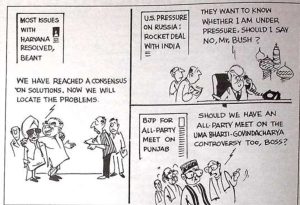A Himalayan size ruckus erupted among the U.S., Russia and India. What’s more, this nasty spat is likely the beginning of a series of confrontations as Washington flexes its muscles in an attempt to curb the spread of missile and nuclear technology in the Third World.
On last Monday, the U.S. imposed a two-year ban on exports of technology to the Russian space agency Glavkosmos, and to India’s Space agency. Further, trade Sanctions are being threatened by Washington against India and Russia,
The fuss is over Russian-designed rocket engine technology. Before the collapse of the USSR, Moscow had agreed to supply India with engines capable of boosting heavy payloads into orbit-or over long distances, Russia has now taken up the contract and is ready to supply India with advanced missile technology.
The angry Indians claim the engines will be used only to launch weather satellites. Washington insists the engines are for Indian medium and possibly long-range, nuclear-armed missiles.
The Americans are probably night. India could easily and more cheaply use Chinese or western missiles to put weather satellites into orbit. Why would impoverished India waste hundreds of millions of dollars on heavy launchers? The answer, quite clearly is for military purposes.
India has had the Third World’ most advanced missile and nuclear programs, In 1974, India explode a nuclear device. This forced Pakistan to begin its own defensive nuclear program. According latest estimates, India has secret!) Developed the capability to produce 10 or so nuclear weapon each year. It may already have 30: 40 operational atomic weapons.
The Indians have already fielded a 500-mile range missile; Giver its inaccuracy, this system can only be useful when carrying a nuclear warhead. It is obviously intended for use against neighboring Pakistan and China.
Now India appears bent on producing a2,000-mile missile which could later be extended to 5,000 mile range, making it a rue ICBM capable of striking China, Europe and even North America,
Washington is determined to abort this project. India had asked the U.S. defence contractor, General Dynamics, to supply the engine technology. But the Bush administration blocked the sale. So New Delhi turned to Russia.
The Russians are now mad as hornets; They say the threat of U.S. sanctions means the deal could fall through, with the loss of 66,000 jobs. While officially denying any military use for its missile program, India still insists it has every right to produce intermediate and intercontinental missile systems. After all, says Delhi, it too is a great power. Why can’t India have nuclear arms like England, France, Israel and China?
India certainly does have this inherent right. But two questions must also be asked, First, why should foreign nations continue to supply massive amounts of food and economic aid to India when it is spending billions on offensive military projects? Second, what is the purpose of India’s nuclear and missile programs?
The answer to the second question is ominous. India has been throwing around its weight in Asia for the past decade. Critics of Indian policy claim New Delhi is trying to assume the imperial role of the old British Empire. Indian interventions in Sri Lanka and threats against Pakistan, Nepal and Bangladesh have heightened such fears. So have India’s huge arms programs and its development of a blue water navy that includes nuclear subs and aircraft carriers, Mighty India, with 950 million people, is not threatened by invasion, Only China’s nuclear arsenal poses a genuine, if distant, concern, India’s neighbors see its nuclear and missile projects as a major sight of growing Indian aggressiveness and an attempt to become Big Brother in the region. India does not need long-range nuclear weapons. It needs food, schools and hospitals. The West is correct in telling India to TECONK sider its strategic ambitions.
Unfortunately, India’s increasingly militant Hindu chauvinists aren’t listening. They see a western plot to keep India weak and at bay, India has also rejected Pakistan’s sensible proposals for a nuclear-free zone in West Asia.
At the very least, foreign donors” should reduce or even cutoff their aid to India and until Delhi stars” feeding its people instead of its strategic nuclear programs.
Courtesy: Toronto Star.

Article extracted from this publication >> May 29, 1992